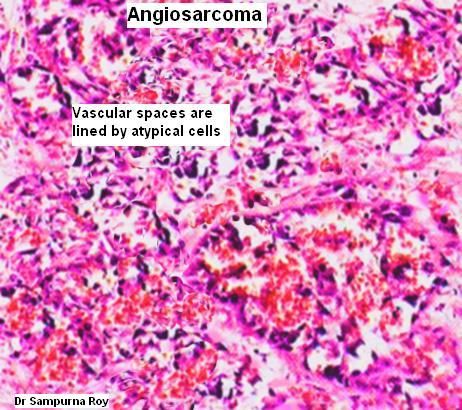lipoma arborescens pathology
Lipomatosis pathology Magnetic Resonance Imaging Male. The following structural rearrangements of chromosomes have been associated with lipoma occurrence.

Atypical Fibroxanthoma Histopathology Image1 Histopathology India Net Pathology Quiz Online Pathology Squamous Cell Epidermis
The diagnosis of lipoma arborescens was confirmed by the.

. The Latin term arborescens means tree-like appearance describing the. Epub 2012 Mar 5. These findings are characteristic of lipoma arborescens.
Lipoma arborescens is characterized by villous lipomatous proliferation of the synovial membrane. Lipoma arborescens also known as diffuse articular lipomatosis is a rare benign articular lesion comprising mature adipose cell proliferation in the subsynovial region with a predilection to the suprapatellar bursa. Clinically the most common finding is a slow-growing painless swelling accompanied by intermittent effusion of the joint.
In a subgroup of lipomas the HMGA2 gene located on 12q143 was involved in tumor pathogenesis. Author P Diana Afonso 1 Affiliation 1 Hospital Garcia Orta Lisbon Portugal. Lipoma arborescens diffuse articular lipomatosis is a rare articular lesion consisting of subsynovial villous proliferation of mature fat cells 1 usually involving the suprapatellar pouch of the knee joint.
In 20 of the cases popliteal cysts were. It has mainly been reported to occur in the suprapatellar bursa but may also involve other joints such as the shoulder ankle or. Lipoma arborescens most commonly occurs between the fifth to seventh decades of life and is a.
Clinical manifestations of LA are nonspecific and frequently resemble osteoarthritis inflammatory arthritis or infection 4 6. It is a rare condition typically present between 50-70 years but has been reported in the young as in this case. The exact aetiology remains unknown the main hypothesis being a response to chronic inflammatory or traumatic stimuli.
Lipoma arborescens is a rare benign intra-articular lesion of unknown etiology in which there is diffuse replacement of the subsynovial tissue by mature fat cells with prominent villous transformation of the synovium. Lipoma arborescens also referred to as villous lipomatous proliferation of synovial membrane diffuse lipoma of the joint or diffuse synovial lipoma is a rare benign intra-articular lesion characterized by villous proliferation of the synovial membrane. Lipoma arborescens is a rare benign intra-articular lesion of unknown etiology that usually involves the suprapatellar pouch of the knee joint.
Albert Hoffa a German surgeon made the first description of lipoma arborescens in 1904. A genetic link has been demonstrated that cites that about two-thirds of lipomas exhibit genetic abnormalities. This article presents three patients who had LA which was diagnosed in the knee in two patients and in the wrist of the third patient.
Details of the clinical and histomorphological examination and treatment in addition to a review of the. Hallel T Lew S Bansal M. Lipoma arborescens LA diffuse articular lipomatosis synovial lipomatosis Hoffa disease is a rare intra-articular lesion of unknown etiology.
Lipoma arborescens LA is a rare pathology consisting in adipose metaplasia of the subsynovial tissue arising from chronic joint inflammation. J Bone Joint Surg Am. It is a rare condition typically present between 50-70 years but has been reported in the young as in this case.
The etiology of this condition still remains unclear. Up to 10 cash back An example of such pathology is lipoma arborescens which is an uncommon cause of intra-articular masses that are slowly progressive typically involving the suprapatellar bursa of the knee 2. MRI remains the gold standard in imaging intra-articular soft tissue pathology and should be the study of choice in differentiating intra-articular lipomas from similar conditions such as pigmented villonodular synovitis and lipoma arborescens.
Villous lipomatous proliferation of the synovial membrane lipoma arborescens. The involvement of both ankles in an otherwise well young man was highly suggestive of an inflammatory seronegative pathology. Associated conditions have included osteoarthritis joint trauma diabetes mellitus.
Lipoma arborescens is a chronic slowly progressive intra-articular lesion characterised by villous lipomatous proliferation of the synovium usually involving the suprapatellar pouch of the knee joint. Lipoma arborescens Arthritis Rheum. Biochemical and Genetic Pathology.
To describe the typical features of lipoma arborescens on MR imaging with pathologic correlation and to evaluate the associated lesions within the joints. The MR imaging findings of 32 patients with the diagnosis of lipoma arborescens of the knee n32 and shoulder n1 were reviewed. Lipoma arborescens LA is a rare benign synovial tumour characterized by the proliferation of mature adipocytes within the synovial cells 15.
Another example is synovial osteochondromatosis which is the result of proliferative and metaplastic changes in the. However the normal inflammatory markers failure to respond to DMARDs and the little benefit from steroid injection. It is an uncommon cause of intra-articular masses that presents as slowly progressive painless swelling of the joint which persists for many years and is accompanied by.

Pathology Of Whipple S Disease Macrophages Containing Diastase Resistant Pas Positive Granules In The Lamina Propria Of Th Whipple S Disease Pathology Disease

Atypical Fibroxanthoma Histopathology Image3 Histopathology India Net Pathology Quiz Online Pathology Squamous Cell Squamous Cell Carcinoma

Pin On Pathology Infographics And Posters

Pin On Systemic Pathology Medicine

Pin On Systemic Pathology Medicine

Pin On Systemic Pathology Medicine

Pin On Systemic Pathology Medicine

Epithelioid Angiosarcoma Histopathology Section 6 Histopathology In Soft Tissue Tumour Pathology Dermatopathology Pathology Tumor Medicine

Lipoma Arborescens Radsource Arborescens

Pin On Pathology Infographics And Posters

Pin On Pathology Infographics And Posters

Pin On Systemic Pathology Medicine







Comments
Post a Comment